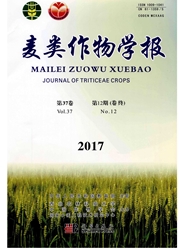

 中文摘要:
中文摘要:
为了系统研究小麦大田麦蚜防治技术,以弱筋小麦扬麦13为材料,调查了抽穗至灌浆期麦蚜与天敌的数量动态,研究了阿维菌素、吡虫啉、毒死蜱和乐果四种农药对麦蚜的防治效果和对天敌的影响以及麦蚜的防治适期。结果表明,天敌量随麦蚜密度的波动而波动,两者关系达极显著水平(r=0.93^**);所选四种农药对麦蚜的防治效果均较好,但生物农药阿维菌素和选择性杀虫剂吡虫啉对天敌的杀伤率较低;在抽穗开花期至花后7d即麦蚜发生初盛期进行一次性施药防治,可获得较好的防治效果;麦田治蚜对灰飞虱有一定兼治作用,但效果不理想。
 英文摘要:
英文摘要:
In the present study, time dynamics of wheat aphids and their natural enemy in weak-gluten wheat Yangmai13 were investigated. The results indicated that the number of natural enemy was fluctuating along with the number of wheat aphids. The common used pesticides, avermectins, imidacloprid, chlorpyrifos and dimethoate provided excellent control for wheat aphids in weak-gluten wheat Yangmai 13. But avermectins and imidacloprid had lower killing rate for their natural enemy. Wheat were treated once at different developing stages including heading, anthesis, the 7th day after anthesis (TDA), the 14th day after anthesis (14DA) and the 21th day after anthesis (21DA), respectively. The results showed that it was appropriate to spray pesticide when wheat aphids are initially prevailing, while wheat are at stages from heading to 7DA. The pesticides had bad effects of controlling small brown planthoppers at time con- trolling wheat aphids. Summarizing all these results, it is suggested that spaying pesticides avermectins or imidacloprid only once could control wheat aphids, increase the yield of wheat, and protect natural enemy when the wheat aphids are initially prevailing.
 同期刊论文项目
同期刊论文项目
 同项目期刊论文
同项目期刊论文
 期刊信息
期刊信息
